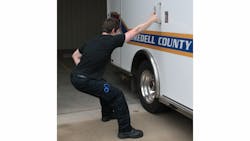Humans were not meant to sit for long periods of time. Humans were definitely not meant to sit for long periods with heavy gear strapped to their torso and hips. Humans were also not meant sit hunched over computers either. The way I look at it, your job has set you up for pain. The benefit of teaching dozens of LEO specific fitness and injury prevention classes around the country each year is that I see a lot of the exact same patterns in almost all of the officers we train.
So here it is from the scientific perspective; an excerpt from one of my peer reviewed journals:
“LEO’s often display a severe upper crossed syndrome due prolonged wearing of ballistic vests, the gear that officers must carry on their person coupled with prolonged sitting and typing in their patrol car. These patterns, day after day, cause the pects, deep neck flexors and shoulder internal rotators to become short and tight often displaying a higher activation threshold. The pain and or “symptom” that they experience is commonly posterior. Headaches, neck pain, rotator cuff and glenohumeral disorders along with upper thoracic pain. We find that when teaching LEO’s to self-mobilize using tennis balls for trigger point massage the pain they experience is profound. For many of these officers simply ‘shutting off the agonist” in this case the pects and subscapularis will give them almost immediate relief of posterior symptoms.”
In a nut shell what this means is that the muscles in the chest wall (pects), front of the neck and under the shoulder blade and lats get very “short and tight.” The muscles in the back become long and weak and they scream at you that there is a problem; we call this the symptom. Unfortunately as a culture we either ignore the symptom all together or we try and fix the symptom not the cause. Take home = pain is posterior, problem is anterior.
Since you cannot change your job and getting out of your car and stretching every hour is not always feasible (or safe), what is an officer to do? First you have to break up the ‘cause’ muscles. Second you have to mobilize the mid-back and finally you have to make the mid-back stronger. Here’s how.
1. Break up the tight chest wall, lats and shoulder blade: Using a tennis ball find the spot that hurts in the chest wall. For each painful spot (healthy tissue does not hurt to touch) hold pressure for 20 seconds and then make tiny circles to break up the tissue. Spend at least 1 minute per area.
Now roll the lats and sub-scapularis (under the shoulder blade) using the same technique with the tennis ball or a foam roller. After you break up all this tissue hold a chest and lat stretch for 60 seconds each side. Break it up then give it a good long low force stretch. You will feel better instantly.
2. Shut off the symptoms: Using a tennis ball and foam roller hit the trigger points and spasms in the upper back and shoulder blades. Same technique as above but there will be a LOT of them so I suggest having the TV on.
3. Now that we have begun to re-set the body and shut off the problem muscles let’s make the upper back stronger. The goal here is to get the “scapular stabilizers” and the “mid-thoracic para-spinals” to work together. This means that we need the shoulder blades to “squeeze together” on each rep of each exercise without the upper traps firing or the low back kicking in.
The common mistake we see when trying to get these muscles working again is the hugs, shrugs, touches and extensions. Basically the muscles between the shoulder blades are so weak that instead of firing them during a standing row as an example you shrug your shoulders, hug yourself (using biceps instead of back), your arms touch your sides to shut off the back or you use your spine and lean back into extension to ‘cheat the movement.’
The way I like to teach it is follow the rules above and imagine “squeezing an egg” between your shoulder blades each rep. Simple exercises like a standing row using a band or cable, a prone row where you lay face down on an incline bench and row dumbbells or the same position while doing a reverse fly are good. Even pull-ups or modified pull-ups will help to get the job done and safely reset those poor back muscles.
Try this protocol 2 times per week for about 4-6 weeks and see how much better you feel.
|
Mobilize the Chest wall, lats, and shoulder blade |
60 sec. each area |
|
Mobilize the Upper back |
60 seconds each spot |
|
Stretch the chest and lats |
60 sec. per stretch |
|
Standing row |
3 sets of 15 |
|
Prone reverse fly |
3 sets of 12 |
|
Prone row |
3 sets of 10 |
|
TRX, bar or partial body weight pull up |
3 sets of max |
|
20 minutes of sustained cardio on the treadmill or elliptical (no sitting) |
|
Here are a few other Upper Back Exercises to help increase strength you can try.
Check out this list of no-equipment Back Exercises.
Here are a few exercises you can do to improve your posture (which affects all upper body muscles).
About the Author
Bryan Fass
is a leading expert on public safety injury prevention. As the president and founder of Fit Responder Bryan’s company works nationally with departments, corporations; state and local governments to design and run targeted injury prevention and wellness programs. He is frequently contacted for expert opinion and content contribution for all aspects of public safety fitness, ergonomics and wellness. Bryan authored the Fit Responder book used by departments and schools plus writes for numerous web and peer-reviewed journals including the NSCA-Tactical Strength & Conditioning journal, officer.com, ems-1.com & best practices in EMS. Bryan holds a bachelors’ degree in sports medicine with over 17 years of clinical practice, was a paramedic for over 8 years, and is certified as an Athletic Trainer (ATC, LAT), Strength Coach (CSCS) and the Functional Movement Screen (FMS). Fit Responder developed the nation’s first validated pre-hire Physical Abilities Test for EMS. Bryan is a sought-after speaker on a variety of topics including risk reduction, employee self-care, real world wellness and How to Eat on the street. www.fitresponder.com
Every Lift Counts!

